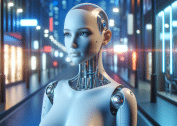Explore how artificial intelligence keeps advancing and see why it influences everything from search tools to medical research. This article unravels the emerging trends, surprising benefits, and under-the-hood secrets of machine learning you might not expect.
Understanding the Core of Artificial Intelligence
Artificial intelligence, or AI, goes far beyond simple computer programs. It mimics human thinking and adapts to new information at speed. Core AI principles involve machine learning, data processing, and decision logic. These tools allow software to sift through big data, identify patterns, and even predict outcomes. AI’s increasing use in smart technologies, from voice assistants to autonomous vehicles, reveals how deeply embedded it is in daily experiences. As systems collect more data and refine their models, they constantly evolve—learning and adapting to become more accurate. Advances have made AI a household term, but there’s still mystery surrounding how computers make sense of such complexity.
Behind every smart search engine result or recommendation system, there’s an AI algorithm at work. But what makes these algorithms different from older computer programs? The secret lies in adaptability. Traditional code operates on explicitly defined rules, but AI models handle ambiguity. They leverage neural networks and deep learning to teach themselves from massive datasets. This means results improve as the AI sees more diverse examples. It’s a learning journey, not a static set of instructions, that drives the AI revolution. Healthcare diagnostics, translation tools, and even customer service bots now lean on this flexible learning curve.
AI also unlocks efficiencies across industries. In manufacturing, predictive analytics powered by machine learning can reduce waste and downtime. In personalized medicine, AI scans complex gene patterns to discover new treatments. The speed and depth of analysis now exceed what the human mind can manage alone. However, with new complexity comes a need for careful oversight. Regulators and scientists emphasize the importance of transparency in how AI decisions are made, highlighting both the promise and challenges that sophisticated algorithms introduce to society (Source: https://www.nibib.nih.gov/science-education/science-topics/artificial-intelligence).
Common Myths and Realities About Machine Learning
Machine learning is often confused with artificial intelligence, but the terms aren’t interchangeable. Machine learning is actually a subset of AI. It focuses on teaching a system to make predictions or recognize patterns from data, rather than following preset rules. People sometimes imagine smart robots or sentient computers, but real-world machine learning is more about predictive text, image classification, or detecting fraud in financial transactions. These practical uses touch nearly every modern industry, even though the underlying code can seem invisible.
There’s another misconception: the belief that AI systems never make mistakes. The reality is that every algorithm depends on the quality and scope of its training data. When developers use comprehensive, balanced data sets, AI makes more reliable decisions. But biases, errors, or omissions can lead to unexpected or even unfair outcomes. Researchers constantly refine their models to minimize these pitfalls, yet the process is never truly finished. Transparency remains key to building confidence in the results and encouraging ethical development.
Automated decision-making sounds futuristic, but it’s now routine in areas like search engine optimization and targeted advertising. AI studies user habits, clicks, and preferences to continually improve the relevance of results. Businesses invest in these solutions to customize online content, boost engagement, and adapt to changing market conditions. As technology advances, so do the mechanisms for safeguarding privacy and ensuring AI is used responsibly (Source: https://www.nia.nih.gov/health/artificial-intelligence-ai-healthcare).
Major Breakthroughs Driving AI Innovation
The leap from basic automation to sophisticated reasoning comes from a handful of major breakthroughs. Deep learning is chief among them, empowering machines to learn from vast, unstructured data. Convolutional neural networks enable software to read medical scans, recognize speech, and interpret photos—all with high accuracy. Another key development is reinforcement learning, which allows AI agents to experiment and adapt based on feedback. With each iteration, their strategies improve, paving the way for smarter decision-making in real time.
Cloud computing has also played a pivotal role in advanced AI systems. It handles the enormous workload of training neural networks by letting machines access powerful remote servers. More organizations now train and deploy models quickly and affordably. Open-source libraries add another boost, enabling collaboration between researchers and reducing barriers to entry. This landscape has accelerated AI research, allowing startups and large corporations alike to experiment and deploy new solutions faster than ever.
What’s most remarkable is AI’s ability to work alongside human experts in fields like drug discovery and advanced analytics. In genomics, AI tools examine billions of DNA sequences to find subtle disease markers. In weather prediction, machine learning models combine real-time sensor data with satellite imagery for greater accuracy. These transformations highlight how human insight and machine efficiency converge, producing discoveries that neither could achieve alone (Source: https://www.brookings.edu/articles/the-potential-and-limitations-of-artificial-intelligence/).
The Expanding Impact of AI on Daily Life
AI now influences daily routines in ways that once felt like science fiction. Voice assistants process natural language commands for everything from scheduling to shopping lists. Smart homes use algorithms to predict climate preferences and save energy automatically. Behind streaming services, AI suggests content by analyzing watch history and broader trends. This seamless convenience is built on a foundation of advanced data analysis and collaborative filtering.
Transport and mobility also benefit from AI-guided management systems. Public transportation schedules update in real time using predictive models that account for traffic and delays. Semi-autonomous vehicles apply vision recognition tools to detect obstacles and navigate roadways. These examples show that technology continues to shrink the gap between human intent and automated action. Small changes add up. Over time, the quality of life improves for many, all thanks to technologies that quietly adapt to individual needs.
Accessibility and inclusion are often overlooked benefits of AI applications. Text-to-speech software and real-time translation tools help bridge language barriers and reach diverse groups. Disabilities no longer stand as insurmountable obstacles as machine vision and speech synthesis enable independent living and learning for more people. Continued research ensures further improvements in how AI supports daily independence and access (Source: https://www.nibib.nih.gov/news-events/newsroom/ai-and-its-impact-healthcare-and-research).
What Shapes AI’s Future and Possible Challenges
The possibilities for future AI use are expanding quickly, but challenges persist. One major consideration is ethical development—ensuring algorithms remain fair and transparent as they affect more personal decisions. Researchers and policymakers debate how best to oversee evolving risks as society leans on algorithms for choices in healthcare, education, and security. Clear guidelines and international cooperation are crucial to keeping innovation safe and ethical.
Another area of focus is responsible data management. AI systems often require enormous data sets, which raises privacy and data security concerns. Organizations are developing new methods to anonymize and protect user data while still enabling rich analysis. Regulation, such as data protection laws, is maturing alongside technology. This ensures companies remain accountable as they deploy more advanced solutions. The continued cooperation between engineers, lawmakers, and the public fortifies trust in AI’s progression.
Sustainability is increasingly central to debates over AI’s impact. Training deep learning models draws on significant computing resources. Innovation in energy-efficient hardware and software—along with a move toward renewable-powered data centers—aims to alleviate the environmental burden. These shifts, combined with public dialogue, help turn AI from a source of risk into a force for good, providing new sources of value for everyone navigating the evolving tech landscape (Source: https://www.nature.com/articles/d41586-022-01272-9).
Learning and Upskilling With AI Tools
AI-powered courses and platforms are reshaping how people learn digital skills. Free online resources from trusted universities and nonprofits offer hands-on experience with real-world systems. Aspiring developers, analysts, and business professionals gain practical knowledge through interactive modules. Platforms like Coursera and edX cooperate with academic institutions to provide structured education in coding, data analysis, and algorithm design. These pathways welcome people from all backgrounds, helping bridge gaps in digital literacy and workforce readiness.
In professional settings, upskilling programs use AI to personalize learning journeys. Adaptive assessments identify strengths and weaknesses, tailoring coursework to individual needs. As automation changes the future of jobs, flexible skill-building ensures workers adapt to shifting demands. Micro-credentials and digital badges serve as proof of newly acquired knowledge. This ecosystem makes it easier for organizations and individuals to measure and verify skill growth.
Continuous learning is now central to long-term career resilience. AI-driven simulations give learners a safe space to experiment, make mistakes, and grow. Industry professionals increasingly look to these advanced solutions for professional development and problem-solving efficiency. As access widens, so does opportunity, democratizing innovation for those who pursue it (Source: https://digitalpromise.org/2023/06/07/how-ai-is-transforming-education/).
References
1. National Institute of Biomedical Imaging and Bioengineering. (n.d.). Artificial Intelligence. Retrieved from https://www.nibib.nih.gov/science-education/science-topics/artificial-intelligence
2. National Institute on Aging. (n.d.). Artificial Intelligence (AI) in Healthcare. Retrieved from https://www.nia.nih.gov/health/artificial-intelligence-ai-healthcare
3. The Brookings Institution. (2022). The potential and limitations of artificial intelligence. Retrieved from https://www.brookings.edu/articles/the-potential-and-limitations-of-artificial-intelligence/
4. National Institute of Biomedical Imaging and Bioengineering. (2023). AI and its impact on healthcare and research. Retrieved from https://www.nibib.nih.gov/news-events/newsroom/ai-and-its-impact-healthcare-and-research
5. Nature. (2022). The environmental impact of artificial intelligence. Retrieved from https://www.nature.com/articles/d41586-022-01272-9
6. Digital Promise. (2023). How AI is transforming education. Retrieved from https://digitalpromise.org/2023/06/07/how-ai-is-transforming-education/











 Unexpected Factors That Influence Home Prices
Unexpected Factors That Influence Home Prices 

